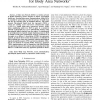404 search results - page 79 / 81 » Privacy Preservation for Data Cubes |
TITB
2010
13 years 4 months ago
2010
A Body Area Network (BAN) is a wireless network of health monitoring sensors designed to deliver personalized health-care. Securing inter-sensor communications within BANs is essen...
DKE
2010
13 years 7 months ago
2010
Trajectories are spatio-temporal traces of moving objects which contain valuable information to be harvested by spatio-temporal data mining techniques. Applications like city traf...
SP
2007
IEEE
14 years 4 months ago
2007
IEEE
Information-flow security policies are an appealing way of specifying confidentiality and integrity policies in information systems. Most previous work on language-based securit...
CTRSA
2009
Springer
14 years 4 months ago
2009
Springer
In the setting of multiparty computation a set of parties with private inputs wish to compute some joint function of their inputs, whilst preserving certain security properties (l...
CVPR
2012
IEEE
12 years 6 days ago
2012
IEEE
In machine learning and computer vision, input signals are often filtered to increase data discriminability. For example, preprocessing face images with Gabor band-pass filters ...

